Text
Flora, Luna-Corona: A Physical Meeting Point of Floral Fashion History, Chinese Zanhua & Untold Stories
In the past few months, I have been working with the Gibson House Museum in Toronto to develop an exhibition inspired by Chinese zanhua (lit. flora-wearing; 簪花) & floral fashion around the world, and this art installation is titled "Flora, Luna-Corona 团花·月華".

For folks from Toronto, Canada:
Accompanying the exhibition, from 1-4pm on this Saturday (July 22), I am hosting a two-part event with my collaborators, Ange & Alaina, at the Gibson House Museum:
1. Artist & educator Ange Loft will lead a tour of the Gibson House, grounded in Kanien'kehá:ka and Haudenosaunee symbolism around florals, farming and fabric.
2. Next to the crabapple tree and being surrounded by the fragrant roses and lilies, we will gather for a casual Q & A. Myself, Alaina, and Ange will share stories and cultural perspectives from the Chinese/Cantonese, South Asian/Pakistani, and Haudenosaunee/Kanien'kehá:ka communities.
Particularly, during the exhibition tour, I will discuss how “Flora, Luna-Corona” is a meeting point between languages, literature, and the on-going history of gender-fluid fashion and 2SLGBT+ identities.
💐
Join us for a floral field trip this Sat at the Gibson House, or take part in a scavenger hunt by following the guidance of a "floral moon", floral scents, and flowery fashion.
Due to capacity limit, please pre-register by email [email protected] and mentioning RSVP to "Flora, Luna-Corona in the Subject line.
🍏📍 Gibson House is next to TTC North York Centre station.
🕒 Special Event: 1-4pm on Sat, July 22
🕒 The exhibition also opens 10am-5pm, Wed-Sun, till July 30.
🌈 The exhibition is wheel-chair accessible and on the 1st floor.
“Flora, Luna-Corona” is part of the Toronto History Museums’ Artist Mentorship Showcase: Pride with Mentor Ashley Mckenzie-Barnes. Experience a range of art projects at 10 history museum sites featuring emerging and mid-career artists from the 2SLGBTQ+ community.
#hanfu#canadianart#traditional clothing#floral#zanhua#簪花#floral fashion#漢服#汉服#lgbt history#Toronto#chinese fashion#indigenous culture#haudenosaunee#south asian
1 note
·
View note
Photo
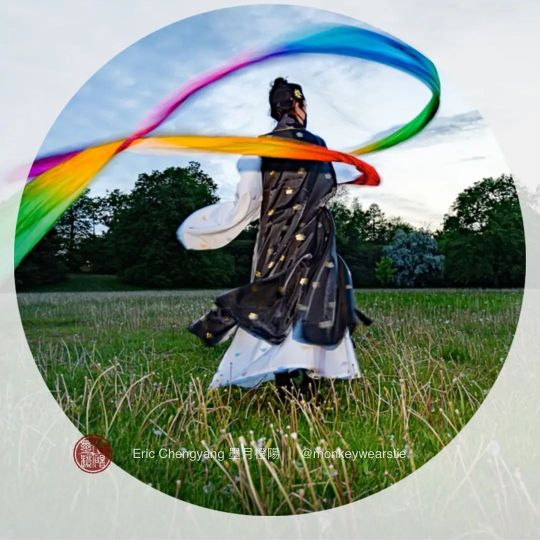
🌈 After collecting bits of rainbow in the past 2.5 years, once again, it's time to sort the wardrobe, and toss the colours towards the clouds of nightfall.
过去两年里, 基本上把目前能找到的彩虹元素汉服款式、配饰都搜了个遍。时逢六月,春辞夏至,是时候让衣橱里存放的虹光再次照明重云与幕色。
This contemporary, full hanfu attire is based on the Mid-Late Ming style. The main layers are outlined below:
衣冠裝束主要參照中晚明風:
+ Daopao: a type of Ming-styled long robe with crossing straight collars and slits at both sides. In contrast to other types of crossed-collar robes, the daopao has a hidden panel/curtain inside each slit, which creates the illusion of an interior, second layer.
+ 道袍: 此處非字面意思,而是指一種特定的明制漢服形制。道袍基本結構與直裰、宋制交領長衫相似, 但其在衣身兩側開衩處, 內接暗擺。如照片中的道袍, 內擺是直接縫在後衣襟上的,從側面看像是藏在開衩處內側的“門簾”。
+ Beixin / Bijia: an unisex, sleeveless jacket usually worn as the outermost add-on. This particular variation has a straight collar with parallel fronts.
+ 直領背心(比甲)
+ A Ming-styled hairnet with an osmanthus zanhua ornament.
+ 網巾、簪桂花(纏花)
https://www.instagram.com/p/Ce9tz0sJC36/?igshid=NGJjMDIxMWI=
#hanfu#lgbt#traditional clothing#queer art#pride month#chinese fashion#汉服#漢服#chinese style#中国风#gaysian#queer fashion
38 notes
·
View notes
Text


明月舞清影 光陰墨潮汐
As the brilliant Moon was playfully dancing
With the shadows,
Wangshu painted the tidal waves
With the light and shade from time
They borrowed
...
🌓
From “When the Phases of the Moon Pull the Tides of Time (明月墨潮生)” - by Eric Chengyang (墨月无觞) on
First Quarter Moon / Neap Tide / 7:45 am from Toronto
–
Updated: connotations is now available here on @dawatyanproject
This project is a crossover project between Dawat Yan Project & Dao: Hanfu: the visual poetry and its corresponding connotations will be distributed between two blogs, alternatively.
–
To be continued during the the following moon phase: 🌗
#visual poetry#hanfu#moon#conceptualphotography#gif art#visual art#moon phases#traditional clothing#canadianartist#art photography
6 notes
·
View notes
Text
Connotations # 1 | When the Phases of the Moon Pull the Tides of Time (明月墨潮生)
1. 望舒 | Wang·shu
Wangshu was an ancient deity who drove the Moon across the sky in a carriage. One of the earliest mentions of this mythical figure appeared in the semi-autobiographical poem by Qu, Yuan, titled "Li Sao":
“前望舒使先驱兮,后飞廉使奔属” — 出自屈原 《离骚》
“…[I would] ask Wangshu, the Deity of the Moon, to lead me with their carriage, and request Feilian, the God of Wind, to follow us as a rearguard…” -- Excerpts from "Li Sao (meaning: The Lament)" by Qu, Yuan, during the Warring States period / 4th-3rd c. BCE
The Chinese term, wangshu (written as 望舒), is also used as a synonym for the Moon itself, especially in literature.
2. 霜髻 |"frosty hair"
化用自李白 《短歌行》 中的 “麻姑垂两鬓,一半已成霜”
This expression is an homage to Li, Bai’s “Duan Ge Xing (lit. The Short Ballad)”, in which he wrote:
“Magu, the Goddess of Longevity, often wears her hair in two parts; however, one-half of her hair has already turned to white frost.”
3. Fragrans
Latin: emitting a smell; sweet-smelling
The binomial name for the sweet osmanthus plant is osmanthus fragrans.
---
Note:
As a crossover project between Dawat Yan Project & Dao: Hanfu, during each moon phase, one part of the visual poetry will be shared in @dawatyanproject or @daohanfu alternatively, while the corresponding connotations will be posted in the other blog.
Please stay tuned for the next part when a "new" moon phase arrives.


望舒繪日晷 折香理霜髻
Before Wangshu, the Deity of the Moon, put an artistic touch on the sundial,
They began by breaking off a branch from an osmanthus tree,
And tied up their frosty hair with the sweet fragrans
...
From When the Phases of the Moon pull the Tides of Time (明月墨潮生) - by Eric Chengyang
New Moon (Super New Moon) / Spring Tide / 5:14pm from Toronto
To be continued in the next moon phase.
8 notes
·
View notes
Photo
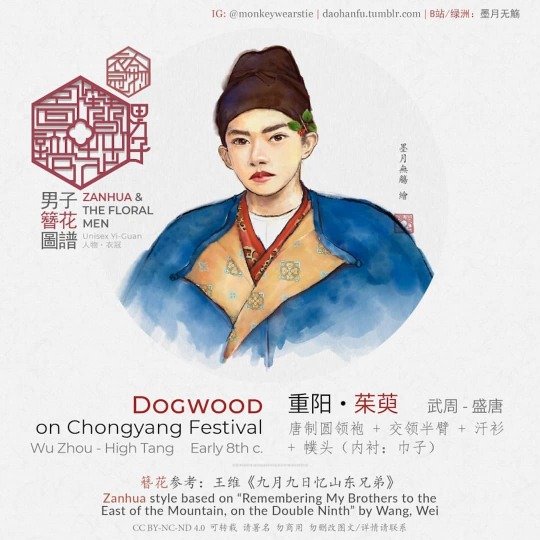
[ENG/中文] Roughly two weeks ago was the Chongyang or Double Ninth Festival, which took place on the ninth day of the ninth month on the lunar calendar. Although the festive vibe has already passed, we can still explore an interesting fashion-custom that was traditionally associated with the Double Ninth Festival: the Men that Wear Flowers.
If you have seen historical Chinese paintings, period dramas, or photos from the contemporary hanfu revival, you will not be surprised to see women with floral hairstyles. However, if we examine Chinese history more comprehensively, we will see that the floral styles were NOT reserved for women: there has been a long-lasting tradition of men wearing flowers, often in the hair or with the headwear. In fact, for both men and women , the customs of flower-wearing are observed and can be found in many cultural groups around the world.
One example of zan-hua (簪花;lit. adorning-flowers) was mentioned in Wang, Wei’s (王维) poem, “Remembering My Brothers to the East of the Mountain on the Double Ninth” (九月九日忆山东兄弟). In the poem, the 8th century Tang-dynasty poet used the act of dogwood-wearing to express his longing for his family and friends afar. Throughout history, this festive tradition had gradually grown into more vibrant forms, as the dogwood worn on men’s hair “bloomed” into all kinds of flowers and plants. This ancient fashion-custom has even survived till modern day to a lesser extent (besides the hanfu revival), such as in Chinese opera.
Inspired by Wang, Wei’s poem, this illustration depicts the floral custom for men during the Chongyang Festival, with an attire and style from the transitional period between the Wu Zhou era and early High Tang, or the first two decades of the 700s AD. A detailed analysis is coming to my Tumblr blog, Dao: Hanfu, soon.
Illustration in #adobefresco
Design in #indesign
重阳佳节虽过, 我们不妨在农历九月的秋色中探讨一个有趣、生动的人文现象–男子簪花。纵观中外服装史、人文艺术史,我们时常看到女子簪花之形象。其实在中外传统服装中,都曾出现或保留有男子簪花的风俗。在中国历史中,此风俗可能源于古老的“重阳戴茱萸”节庆习俗。如盛唐诗人王维曾在《九月九日忆山东兄弟》中,以“遍插茱萸少一人”来描写他对家乡亲朋的思念。
–《#男子簪花 图谱》之茱萸
#traditionalclothing #illustration #hanfu #汉服 #漢服 #chineseclothing #floralfashion #unisexfashion #fashionhistory (at Toronto, Ontario)
https://www.instagram.com/p/CVuJFDmg2hE/?utm_medium=tumblr
#adobefresco#indesign#男子簪花#traditionalclothing#illustration#hanfu#汉服#漢服#chineseclothing#floralfashion#unisexfashion#fashionhistory
67 notes
·
View notes
Text
Originally posted during First Quarter Moon / Neap Tide / @11:25pm, Oct. 12, 2021 from Toronto
------
Initially inspired by the Emirati tarboosh and Arab clothing, I started an exploration with @mariammagsi through our collaborative Dawat Yan Project, and we are exploring how people from different civilizations have associated or attached the sense of home, family, and memory to objects, and particularly, to our shared Moon.
My part, titled “When the Phases of the Moon Pull the Tides of Time (明月几时有 光阴墨潮生)”, is intended to be a crossover between @dawatyanproject and Dao: Hanfu. (Yes! I finally remember how to log-in).
Starting with this first post, and by following the Moon’s movement, I will also be exploring how to incorporate and engage hanfu (and related cultural elements) in a cross-cultural conversation and other collaborative environments.
While I hope you check out our posts, please stay tuned for the next Moon Phase. (No worries! I am not a werewolf, yet).
When the Phases of the Moon Pull the Tides of Time | 明月几时有 光阴墨潮生: #1 (First Quarter)
First Quarter Moon / Neap Tide / @11:25pm from Toronto, ON

During the pandemic lockdown, I like to watch “How-To-Wear” videos of people putting on their traditional/ethnic clothing, as the content provides a sense of connection to the outside world.
One day, I came across a video introducing the Emirati kandura, a regional variation of the Arab garment also known as a thawb or dishdasha (note1). The presenter mentions that the Emirati kandura is often worn with a long tassel-like piece called a tarboosh (plural: tarabeech; note2), dangling from the neckline.
Dating back to the nomadic history of the Bedouin people, the tarboosh is an important cultural and poetic object in Arab culture: before the travellers left home for a trip, their family members would infuse the tarboosh in fragrance, so that the scent from home could stay with the travellers during their journeys.
In history, especially during times when travelling was more difficult and long-distance communication took significantly longer, people of different civilizations had found creative ways to make the concept of home, family, and memory portable.
Keep reading
16 notes
·
View notes
Photo

Last year, I decided to take a break from social media in order to to re-evaluate the priority of my projects and practice. As I had crossed the line and entered the 30s, I realized a need to develop a more comprehensive understanding of our world, and to reposition myself and works in relation to this world. One major thing I have been examing is how to use cultural traditions and heritage as actual, PRACTICAL tools and mediums to establish meaningful relationships and symbiotic understandings, as opposed to isolate, to divide, and to alienate. Overall, culture and arts can be STRONG bridges to connect different "circles" of subcultures, subgroups, and communities. One of the things I did before the lockdown was to start the collaborative Dawat Yan Project with @mariam_magsi . To continue this collaboration, and to reflect the above thoughts in a more tangible way, let's begin by observing the time, When the Phases of the Moon Pull the Tides of Time: + Coming on OCT. 1, on Dawat Yan Project's Tumblr. (A crossover between #DawatYanProject & #Daohanfu / #道漢服 #道汉服) #photography #conceptualphotography #moon #crossculture #canadianart #chineseclothing #traditionalclothes #hanfu #汉服 #漢服 #唐装 #唐圓領 #唐圓領 #contemporaryart #conceptualart (at Toronto, Ontario) https://www.instagram.com/p/CUtg920NKhk/?utm_medium=tumblr
#dawatyanproject#daohanfu#道漢服#道汉服#photography#conceptualphotography#moon#crossculture#canadianart#chineseclothing#traditionalclothes#hanfu#汉服#漢服#唐装#唐圓��#contemporaryart#conceptualart
37 notes
·
View notes
Text
This is an illustration and text I created for the @dawatyanproject , an art collab I am working on with my friend @mariammagsi . In short, the Dawat Yan Project is an exploration of cultural stories and cultural representations through food.
For our first posts, Mariam and I took on the culture of tea consumption in both Pakistani and Chinese communities, since tea serving is viewed as a gesture of hospitality in both cases.
This blog post is the first part of a three-part article, in which I am exploring the plural identities of culture and communities through tea: an important fact that is sometimes neglected by people due to prejudice, biases, as well as racism and cultural supremacy.
To help you navigate, the article is divided into two parts:
Part one talks about how tea, especially green (unfermented) tea, is NOT a singular concept in Chinese culture.
Part two is an “investigation” of the curious name of the tea known as Sanpaotai or literally, “three-part artillery fortification”. Sanpaotai (as shown in the illustration) is a mix-ingredient tea commonly seen in the Northwest of China, especially in the Hui (Muslim) communities from the region.
Sanpaotai pt. I: a warm welcome to the Dawat Yan gathering

Tea offering is a gesture of hospitality in both Pakistani and Chinese communities.
When Mariam and I decided to start the Dawat Yan Project with the topic of tea and a remote, symbolic offering, I was puzzled by this fairly straightforward topic.
Keep reading
20 notes
·
View notes
Text
This post makes several valid points about Mulan’s famous “hair cutting” scene from the 1998 animation. Thank you! As someone who has long hair, I’d like to share a few personal insights:
I use the traditional “zan(簪)” hairpin to keep my hair in a knot on a daily basis. In reality, the longer my hair is, the easier it is for me to tie the hair into a knot, and to keep the knot intact throughout the day.
The same principle can apply to using ribbons, because a large bun/knot allows the person to tie the ribbon tighter, and the ribbon will not slip.
While I think the original Mulan still has a lot of classic scenes and characters that should be kept in adaptations, the “hair cutting” scene wasn’t very practical or culturally accurate.
About Mulan's Not Cutting Her Hair
Some of you have been complaining so hard about Mulan not cutting her hair. Please allow me to explain.
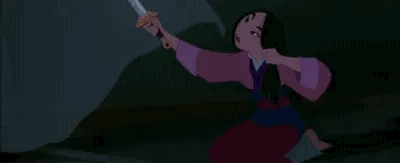
THIS.SCENE.IS.SO.WRONG
(although it is poetic cinema, I'll admit :P)
Ancient Chinese follow the Confucius Principles like gospel. The Emperors also use these principles as the basis of many laws and regulations.
And Confucius sees every part of the body as a gift from your parents, and Chinese people value filialty. Therefore, it's an unfilial act to cut off your hair, almost a sin really. So the story about a filial daughter with a scene about her committing an act considered unfilial in her time is really inaccurate and doesn't make any sense.
Everyone. I repeat. EVERYONE, regardless of gender, in Ancient China has long ass hair. Cutting hair short as symbolism of "masculinity" is purely Western ideas. I've always cringed at that scene in the animated version.


See how guys in Ancient China has long hair too in Chinese movies?
Not to mention the impracticality of tying hair that short into that high a bun, it doesn't work. I'm glad this scene is cut out tbh.
4K notes
·
View notes
Photo

A re-imagined Beiluo (北洛) in historically accurate Ming dynasty clothing (Ming-styled hanfu), based on the video game, Gujian 3 (古劍奇譚三).
Since this is a fictional game character, my goal is to find a mediation between the original character design and historical accuracy, and to picture what Beiluo might look like in real life or a IRL adaptation.
The story of Gujian 3 is set in a fictional, jiakong (架空) time period & universe, with elements inspired by the Ming dynasty in real life. Many cultural and visuals references to the Ming dynasty can be found throughout the game. After examining Beiluo’s default costume, I realize its layers and structure closely resemble the rong-zhuang (戎裝; lit. military or martial attire) of Ming dynasty, a design choice that fits well with the characterization, since Gujian 3 is an action-based RPG.
In this re-imagined character illustration, I try to ensure the basic structure, logistics, and function of the clothing can truthfully reflect historical examples, while I keep several elements that make the character recognizable, such as a simplified version of Beiluo’s original hair and several motifs from the game.
Tool | 繪畫工具: Adobe Fresco on Ipad
-- English ends | 下方中文
這張二創裏的北洛形象是根據真實的明代裝束(明制漢服)重新想象的。
在畫之前,仔細分析了下北洛的出場裝,根據衣服的整體層次和搭配來判斷,游戲原設定應是在明代戎裝的基礎上進行了動漫化改編。因為考慮到《古劍三》是以明代為藍本的架空世界(宣傳期爆料與游戲正篇細節皆有證明),這里的二創是一種 ACG 與現實服飾的折衷,也可以看作是游戲人物與明制漢服實物的中和。我的出發點是保證衣裝符合傳統穿搭層次與邏輯,且在服裝與人物背景設定不冲突的前提下,融入原作中的動漫元素以保留人物辨識度。
請注意,此 ACG 衍生篇並非純復原向的作品,與《人物·衣冠》系列里的其他復原向作品的出發點不同。請勿與此系列中歷史人物形象混淆。
#gujian 3#古劍奇譚#hanfu#traditional clothing#adobefresco#digital illustration#chinese fashion#ming dynasty#插畫#漢服#北洛#cryg#人物衣冠acg
61 notes
·
View notes
Photo

[ENG/CHN] This was the attire I planned for this year’s Pride in the past June. I have started a personal tradition a few years ago after I moved to Toronto, that I will always incorporate a rainbow item into my daily outfit during the entire month of June. This year, I actually found a hanfu design and a traditional hebao (pouch) in a rainbow palette. Since Pride and other professional events were cancelled due to the pandemic, I decided to continue this tradition in my own way, through photography in the “social-distancing” style.
This Tang styled yuan-ling-pao (#圓領袍; lit. robe with a round neckline) fits the “rainbow" theme quite well, since this style of hanfu is historically unisex, and it implies an interesting fusion of foreign (possibly central Asian) culture and domestic culture of ancient China at the time.
這套漢服穿搭本來是為今年六月的多倫多LGBT驕傲月準備的。每年六月,我都會在每日穿搭中融入一點彩虹色元素。今年真讓我真找到了五彩配色的漢服和配飾,于是嘗試做了個漢洋折衷風的偏日常漢服穿搭。可惜因為疫情,各類工作和驕傲月活動被取消了,只能在宅家期間,換種方式,將早已準備好的衣服用自己熟悉的攝影風格來呈現。這套唐制圓領袍非常適合這個五彩斑斕的彩虹主題。其多彩的花紋與復原向的版型讓衣服本身呈現出了一種中西結合、古今交融的韻味 – 古韻今繹系列 · 漢服穿搭篇
Hanfu designer | 漢服設計(僅限圓領袍): 謎阿凰
Hebao pouch by | 荷包: 暮歸見月
- #hanfu #traditionalclothes #prideoutfit #mystyle #unisexstyle #chineseclothing #chinesestyle #tang #photography #lgbt #漢服 #汉服 #唐制 #圆领袍 #漢洋折衷 #汉洋折衷 #中国风 #攝影 #光影
(at Toronto, Ontario)
https://www.instagram.com/p/CCpQKurgX1s/?igshid=1xcrlwq7qcfuz
#圓領袍#hanfu#traditionalclothes#prideoutfit#mystyle#unisexstyle#chineseclothing#chinesestyle#tang#photography#lgbt#漢服#汉服#唐制#圆���袍#漢洋折衷#汉洋折衷#中国风#攝影#光影
20 notes
·
View notes
Text
Extra Resources for CRYG: Mulan’s Historically Accurate Render & Research
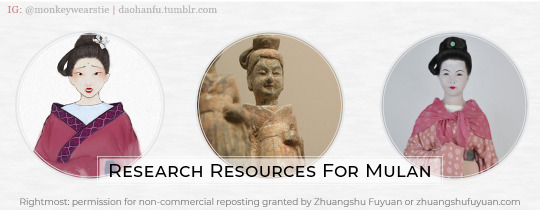
First of all, I’d like to thank everyone whom shared and liked my (Relatively) Historically Accurate Mulan I | CRYG post.
I am delightfully overwhelmed with all the responses from the past week, especially after I had some frustrating struggles with Tumblr’s anti-spamming and tagging system. As a result, I had to take out some very interesting references and external links from the original post.
If you are interested in learning more about the historic-cultural context of Mulan, or want to create your own historically accurate interpretations, here are some resources you’d be interested:
--
Zhuangshu Fuyuan 装束复原 (Chinese Historical Costume Restoration Team). They now have a Chinese WordPress site (might need Google Translate): zhuangshufuyuan.com
This Chinese indie group has made several live-action reconstructions of the fashion from the Northern & Southern dynasties (link).
In comparison to miniature sculptures and 2D paintings, their real-life reconstructions provide a better sense of the scale, layers, and structures of different historical Chinese clothing.
If you can read Chinese, I suggest you to check out their writings, as their essays provide an understanding of Chinese clothing from the angles of design thinking, art and cultural history, and beyond the aesthetics.
You can also find them on Weibo via. @zgzhuangshu
--
China: Dawn of a Golden Age, 200-750 A.D. by the Metropolitan Museum. A free pdf can be accessed on the Met’s website (link).
A great portion of this English publication centers around the Northern & Southern dynasties. Since it is more of an art history book, there are a lot of visuals, and the writing is easy to read.
I want to point out this 2004 publication does contain errors, improper translation, and some outdated views or theories.
Particularly, I’ve noticed many descriptions and English word-choices of historic Chinese clothing are incorrect and can be misleading.
These errors are understandable, because there have been more archaeology discoveries made, and way more research done on Chinese clothing and fashion history, since the book came out.
I still recommend this book, as it provides a well-rounded, overall intro of the historical context of Northern Wei and the entire history of a very complicated era, collectively known as the Three Kingdoms, Two Jins & the Sixteen Kingdoms, and the Northern and Southern dynasties. (The complexity is reflected through this lengthy, already-abbreviated name.)
--
ROM (Royal Ontario Museum) Online Collection. The ROM houses a significant amount of Chinese artifacts from the Northern & Southern dynasties.
https://collections.rom.on.ca/search/Northern%20Dynasties/objects
After you visit the link, make sure you click on Filter >> Country >> “China” (case-sensitive), and all relevant results should be sorted.
If the above link doesn’t work, simply go to ROM’s online collection (here), and search any of these keywords: Northern Dynasties - Northern Wei - Northern Zhou - Northern Qi - Western Wei - Eastern Wei
Note: as explained in the CRYG: Mulan I post, Western Wei / Northern Zhou & Eastern Wei / Northern Qi, are the two different continuations of the disintegrated Northern Wei.
--
Wikimedia Commons:
https://commons.wikimedia.org/wiki/Main_Page
The best part about Wikimedia Commons is that most contents are released in the Public Domain or with Creative Commons licenses that allow remix & reuse
For Northern Wei arts, simply search the keyword: Northern Wei
--
Due to the concern of length, the info presented in the original CRYG: Mulan I post is merely the tip of an iceberg. Therefore, I hope these additional resources can aid you in your own research and/or satisfy your own interests.
Of course, there are many other valuable resources on the Internet. I will have to save them for future updates of the CRYG: Character Reimagined Yi-Guan series.
PS. Due to these external links, this post will likely be hidden from Tumblr’s searches and tags, please manually re-blog if you find it useful.
176 notes
·
View notes
Text
(Relatively) Historically Accurate Mulan I | Character Reimagined Yi-Guan 人物·衣冠 木蘭
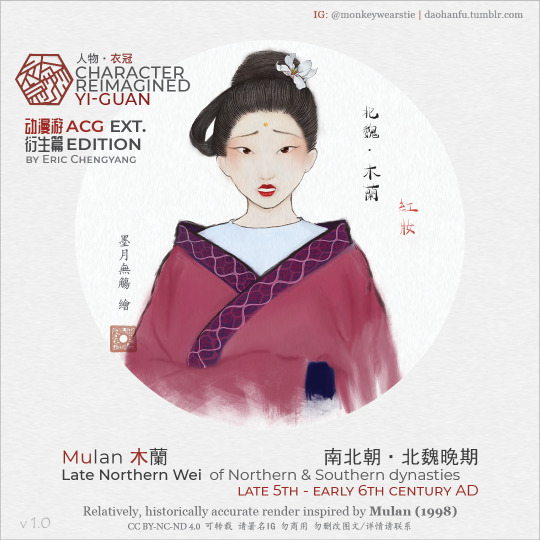
A re-imagined Mulan (花木蘭) in a relatively, historically accurate fashion from the Luoyang-era of the Northern Wei dynasty, inspired by the 1998 Disney film.
First, I’d like to introduce the term, hong-zhuang (紅妝), because many folks had mistaken Mulan’s matchmaking style as a Geisha’s attire since the release of the 1998 film.

Brief Historical Context
Northern Wei dynasty (386-545) took place during several centuries of divisions in Chinese history. N. Wei was a multi-ethnic state founded and ruled by the Tuoba clan of the Xianbei people (拓跋鲜卑). There was also a significant Han Chinese population, especially in the south of the state, such as near the southern, third capital, Luoyang in late 5th century. Perhaps due to the impacts of frequent cycles of disintegration-unification, as well as the lengthy division between North and South, war were common during this time. Such historic context laid the bedrock for the Ballad of Mulan, and it was implied in the poem or folk song that the decade-long war was bloody and sorrowful. In 500s AD, due to political & cultural complications, N. Wei was eventually split into Eastern Wei / Northern Qi and Western Wei / Northern Zhou.
Historical Accuracy & Mulan’s Yi-Guan 衣冠 (lit. clothing-headwear)
I can only do an approximately accurate render due to this complex historical context and related research difficulties, such as the contesting backgrounds of Mulan, and the lack of legible visual evidences from the N. Wei dynasty.
Particularly, by examining the locations mentioned in the Ballad of Mulan and historical records, many research I read suggests that the war mentioned actually took place in the earlier years of N. Wei dynasty. Since there was a drastic cultural-political shift in late N. Wei (late 5th century), the actual yi-guan attire from the earlier era might look different from my render of Late Northern Wei fashion.

In my render, Mulan’s garment and hairstyle is based on actual Northern Wei figurines (above left).
Since most N. Wei artworks I found online has faded colour around the facial features, Mulan’s hong-zhuang makeup is inspired by the arts of Western Wei and Northern Qi dynasties, aka. the two different continuations of the divided Northern Wei. (see above right)

About Yi-Guan Style
The above collage shows artworks from both Northern & Southern dynasties of the same century.
The yi-guan style of Mulan consists of two main parts: layers of top robes + a long skirt. This style known as yichang 衣裳 or ruqun 襦裙 (lit. tops & skirt), can be seen in the arts of several preceding dynasties, from Eastern Han dyansty to Jin dynasties.
Since this particular variation of yichang has appeared in the arts of both N. & S dynasties, Mulan’s N. Wei style is likely a hybrid of Xianbei culture, Han culture, and foreign (Central Asian) influences.
Furthermore, there are many visual evidences that show heavy Sasanian-Iranian and Sogdian influence on the material culture and arts of Northern Wei: a politically troubled yet culturally vibrant era. (an example below)
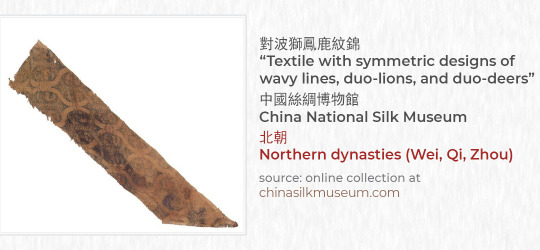
Thank you for reading this post. Please stayed tuned for the future development of this series: Character Reimagined Yi-Guan.
Image usage & credit: please see the bottom of each individual image - Illustration and text by Eric Chengyang 墨月無觴
++
Additional note: Mulan’s makeup and facial expression
Thank you to fate-magical-girls for pointing out in the comments, that Mulan’s frowning brows in the render resemble ti-zhuang (啼妝) or lit. the “weeping-makeup”, a type of makeup style mentioned in the Book of the Later Han. Just to clarify, this render of Mulan was primarily based on the Reflection scenes from the Disney film, and so Mulan’s expression is NOT a part of the makeup, but an actual emotion inspired by the plot.
#mulan#disney#historically accurate#chinese fashion#traditional clothing#hanfu#漢服 汉服#CRYG#人物衣冠ACG#hongzhuang#紅妝 红妆
469 notes
·
View notes
Text
Technical Issue with Tumblr
My apology. Due to an issue with a bug on the Tumblr IOS app, the entire Historically Accurate Mulan post was automatically wiped when I tried to save my post after I fixed the Tumblr hashtag issue on my Ipad. I will have to remake the entire post tomorrow.
2 notes
·
View notes
Photo

This is an untitled work-in-progress for a series that I have been conceptualizing for the past two years, and it is inspired by the metaphoric concept of “hanfu jianghu” (汉服江湖) mentioned in Yang, Na’s book, “Hanfu Guilai” (杨娜著《汉服归来》).
Jianghu (or jiang-hu; 江湖; lit. rivers-lakes) is a historical term that carries complex meanings. In short, jianghu (江湖) can be used to describe a complex and often anarchist society or sub-cultures, in which different sects and groups are co-existing, clashing, and yet, entwined. While most Chinese speakers might be familiar with the “jianghu” universes portrayed in martial art, Wuxia literature and films, “jianghu” is indeed a concept originated from the real life and historical texts. (Jianghu is pronounced as Jeeang Hoo)⠀
In regard to the Hanfu Movement, I think the metaphor of “hanfu(‘s) jianghu” vividly captures the complexity of the clashing and entwining groups of thoughts that have appeared during the past 16 years: ranged from liberal, progressive ways of thinking to ultra-conservative and racist ideologies. Furthermore, cultural tradition is a double-edged sword: while it can be inspirational and empowering, it can also be utilized as a tool of oppression and discrimination. I have witnessed people manipulating culture and history in order to provide a “logical” foundation and reason for their hatred and bigatory. There are so much more to be discussed, and yet, I don’t know where to begin or end. Like the image, I will unfold these layers gradually in the future.
Hanfu style: yichang (衣裳; top robe and unisex skirt) + pifeng (披风; a loose, jacket-styled coat with wide sleeves)
All Rights Reserved ©Eric Chengyang (Please do not repost the image without permission. Reblogging the post with the caption is fine, I just don't want people to read the image without the context written above, and it is a work-in-progress.)
https://www.instagram.com/p/B-539ccAjKf/?igshid=gqubpjbwm16n
10 notes
·
View notes
Photo

"Dao (Paths) | 道·路", 2018, digital print mounted on paper boards.
Dao (道), is a hanzi (Han-Chinese) character which has multiple meanings. Depending on the context, dao/道 can mean:
Passages or paths, such as roads, waterways, etc.
To speak or to talk, and often used as a synonym for shuo (说; to say).
The methods or process of achieving a goal, or simply, a metaphoric path
A philosophy relating to the law and order of the natural world and its occurrences, such as the central philosophy of Daoism (Taoism)
Skill sets that are often technical, artistic, and/or ritualistic, such as xiang-dao (香道; incense ceremony), cha-dao (茶道; tea ceremony)
Narrow, linear marks and traces
By referencing these different definitions, "Dao" is an extensive series of artworks discussing the complexity, pluralism, and conflicts of the Hanfu Movement, and how the Hanfu Movement connects and intersects with the various issues within Chinese societies and the world at large. "Dao (Paths)" is the first entry in the series, and the long journey continues on.
6 notes
·
View notes